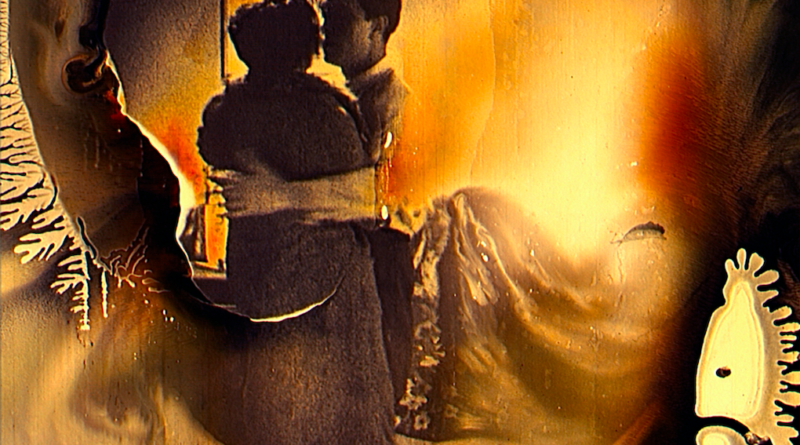INTERVIEW: Bill Morrison’s latest film combines opera music with archival film
Photo: Let me come in, directed by Bill Morrison, repurposes forgotten footage from 1928’s Pawns of Passion. Photo courtesy of TCM / Provided by press rep with permission.
Bill Morrison, the acclaimed filmmaker, has built a career out of reinterpreting archival footage that has been lost and forgotten for decades. He has brought his artistry to such projects as The Miners’ Hymns, The Great Flood and Dawson City: Frozen Time. His latest is a short film called Let me come in, which recently played the TCM Classic Film Festival.
In Let me come in, Morrison marries archival footage of the 1928 German film Pawns of Passion with operatic music composed by David Lang and performed by soprano Angel Blue. The result is a new take on an old classic, one that has been decaying for quite some time.
“This film has sort of an interesting history,” Morrison said in a recent Zoom interview. “I’ve learned that it was panned by The New York Times when it came out, and iMDB calls it a lost film. But a print made its way to a collector’s collection that was stored in a barn in Pennsylvania for decades, and when that collector passed away, the film preservationist Bruce Lawton donated the entire collection to the Library of Congress.”
Pawns of Passion was part of this collection, but unfortunately it was deemed virtually unsalvageable with its years of decay and certain reels falling apart. Morrison, however, saw potential.
As a filmmaker, he has a unique relationship with the Library of Congress, and he often visits the institution for a variety of projects. “They will save certain reels that otherwise they’re going to throw out, but they think that I might have some interest,” he said. “They put my name on a Post-It note and put it on the shelf, and at least once a year, I’ll come down to Culpepper, [Virginia,] and spend the night down there and see what’s accrued. So this was back in 2012 when I first saw Pawns of Passion, and in 2013, I got a scan of it. It really sat on a drive on my shelf ever since, and it wasn’t until this new project came along that I could dust it off and put it up against this music.”
Morrison was quick to point out that this project started with Lang, who had worked with the filmmaker on The Village Detective: a song cycle. That work took up the bulk of 2020 and was recently released. Then, at the end of last year, Lang said that LA Opera had approached him with a commission to write a new song as part of the company’s digital series.
“They had asked composers to collaborate with filmmakers of their choosing to make a new short film as part of a way of getting opera out to people during the pandemic, so David chose me,” Morrison said. “And I’m grateful he did. He presented this song that he’d written, the basis of which was a single verse in ‘The Song of Songs.’ … He tracked down different translations of this verse and alphabetized them and edited them so that it became sort of this dirge. Then [he] set it to music, and ultimately LA Opera made a master recording with a wonderful soprano, Angel Blue, recording it. It was really her interpretation of it that put me in mind of this footage that I’d seen years ago and still had on a drive, so I brought that drive down and started playing with it. And in very short order, I saw how well the lyrics and the music and the image all meshed together.”
To Morrison, this old, decaying footage is beautiful, and he has staked his career on finding that beauty and showcasing it for contemporary audiences. He understands that perhaps not everyone shares his view, but he stands by these old prints and forgotten classics.
“I’ve done little to enhance that [decay],” he said of Pawns of Passion. “I’ve slowed it down a bit, in some cases increased the contrast, but there’s very little video editing done to the decay itself. Not only do I think it’s a phenomenologically amazing, but it also puts you in the mind of the past that has taken place before, and what this footage had to go through to come before our eyeballs today, and what has happened to those actors, and what it meant that they were filmed back then and all sorts of associative thoughts.”
Morrison said there’s enough additional material out there that he was able to understand what type of film Pawns of Passion was in 1928. According to iMDB, the movie depicts a Russian ballerina who is searching for a boy throughout Europe after 1917. She eventually falls for a Parisian artist.
“Not all the scenes are as bad as this one,” Morrison said of the scene he chose for Let me come in. “I’ve chosen some of the worst, and I wouldn’t say that I can definitively say that there’s no other print out in the world. Again, it’s a German film, so there could be one in a German archive somewhere or somebody’s attic in Germany that just hasn’t been explored yet. I think with how 4K scanners have become more popular and affordable and allow us to scan film images without using sprocket holes, it’s made a whole host of images and films more accessible to us, and it could very well be that in some archive in Germany or Russia or Poland or somewhere another print of Liebeshölle, as it was known, could be discovered.”
By John Soltes / Publisher / John@HollywoodSoapbox.com
Let me come in, directed by Bill Morrison, recently played the TCM Classic Film Festival. Click here for more information.

